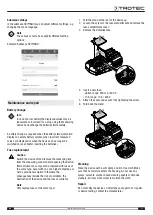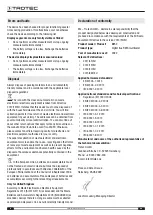
EN
5
digital true RMS multimeter BE52
Information about the device
Device description
The multimeter is a battery-powered, mobile hand-held
measuring device with an extensive range of measurement
possibilities. The true RMS measuring function allows for the
precise measurement of sinusoidal and non-sinusoidal signals
generated due to faults, e.g. by frequency inverters or switching
power supplies of computers.
The device is equipped with the following functional properties
and equipment features:
•
Automatic / manual range selection
•
LCD display
•
Can also be operated while wearing gloves
•
Fold-out stand and holding fixture for measuring tips
•
AC and DC voltage measurement
•
Measurement of direct and alternating currents
•
Resistance measurement
•
Capacitance measurement
•
Frequency / duty cycle measurement
•
Diode testing function
•
Acoustic continuity testing
•
Hold function
•
Calling the maximum and minimum value
The integrated Bluetooth function makes it possible to connect
the device to a terminal device via the Trotec MultiMeasure
Mobile app.
The measurement results can be displayed and saved on the
terminal device either numerically or in form of a chart. Then,
the measurement data can be sent in PDF or Excel format.
The app also includes a report generation function, an organiser
function, one for customer management and further analysis
options. Moreover, it is possible to share measurements and
project data with colleagues in another subsidiary. If
MultiMeasure Studio Professional is installed on a PC, you can
even use report templates and ready-made text blocks for
various fields of application to turn the data into professional
reports.
Overvoltage protection and measurement category
The power grid is permanently subjected to short-time voltage
peaks, the so-called voltage surge, which can be very low, for
instance when a light switch is actuated, but also very high
when a network operator switches over power lines. The height
of the surge voltage depends on the position within a low-
voltage network in which a device/machine is operated. The
closer this position is to the supply line, the higher is the surge
voltage to be expected. This means that an electricity meter of a
house must be able to absorb a higher surge voltage than a
Wlan router.
For the purpose of simplification, the power grid is divided into
four overvoltage categories. A rated surge voltage is assigned to
overvoltage categories in each case, indicating the voltage
peaks for which a device has to be designed:
Overvoltage
category
Rated surge
voltage
Examples
CAT I
1500 V
Devices with power
adapter:
e.g.: laptops,
monitors,
telephones
CAT II
2500 V
Devices with cold-
device plugs:
e.g.: household
appliances, printers,
laboratory
equipment,
telephone system
CAT III
4000 V
Devices without a
plug:
e.g.: sub-
distributions,
cables, sockets,
CNC machines,
construction cranes,
energy storage
systems
CAT IV
6000 V
Devices at the feed
point:
e.g.: electricity
meters, primary
overcurrent
protection devices,
main switches
In line with the overvoltage categories there are measurement
categories defining the permissible scope of application of
measurement and testing devices for electrical equipment and
systems in low-voltage networks.





































